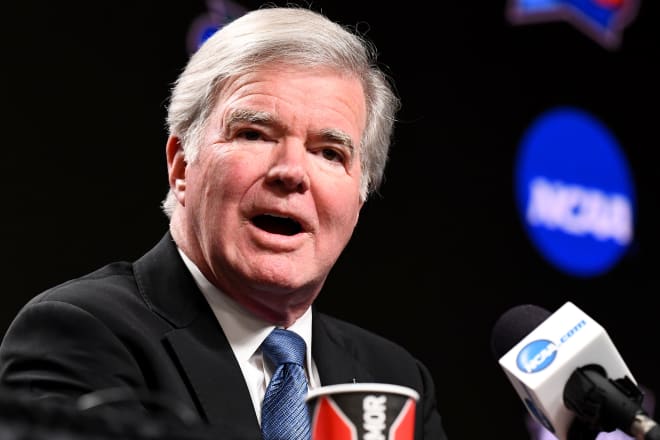Rivals Rankings Turn 20: Analysts predict how recruiting will change

There have been so many monumental changes in technology and every other aspect of society in the last 20 years including in recruiting. It’s nearly impossible to predict what will happen over the next 20 but in today’s roundtable wrapping up our weeklong coverage of 20 recruiting classes at Rivals, we ask the analysts how they envision recruiting changing over the next 20 years.
*****
RIVALS TURNS 20: The top No. 1 classes in our history | Ranking the No. 1 prospects | How the No. 2 prospects fared | Coaching turnover over the years | Power Five recruiting rankings over the years | Head coaches over the last 20 years
CLASS OF 2022 RANKINGS: Rivals250 | Position | Team | State
CLASS OF 2023 RANKINGS: Rivals100
RIVALS TRANSFER TRACKER: Stories/coverage | Message board
RIVALS CAMP SERIES: Info/coverage on 2021 camp series
*****
ADAM FRIEDMAN
The impact of NIL legislation will probably be the biggest difference between recruiting now and 20 years from now. It's going to be interesting to watch how the relationships between the players, coaches, teams, and the business world collide and what kind of effect they will have on visits, commitments, and recruiting tactics. There will surely be significant enhancements to the virtual visit experience as colleges have more time to improve their production. Pop culture and the latest social media trends will also continue to find their way into the recruiting world.
*****
ADAM GORNEY
In some ways, 20 years was not that long ago. In others, it was forever ago. The first iPhone was released in late June 2007. For the first Rivals rankings in 2002, Google was four years old. Facebook was created in 2004. Twitter came along two years after that. All that is being said to point out just how dramatic the technological changes have been across the board and how they’ve affected college football recruiting. Zoom calls are now commonplace. Campus tours over virtual reality and augmented reality headsets will almost definitely be a thing. It wouldn’t shock me if players will be able to watch games in some kind of AR setting from any campus they choose on any given weekend. It will be those stories we’re telling. Advancements in technology will change how recruiting is covered. Name, image and likeness legislation will as well. That is a complicated subject but recruits are going to be swayed to certain schools that have had players make lots of money for NIL deals. Just like facilities and uniforms and meeting with the business school dean, NIL will become a massive part of the recruiting process. And there could be tectonic shifts in which teams are national powers. In 2002, Miami played in the Big East and for a national title. Nick Saban won’t be coaching in 20 years. Will Dabo Swinney at still be at Clemson? Lincoln Riley at Oklahoma? Ryan Day at Ohio State? I would imagine not. So much will be changed but kids will still be kids making major decisions for their lives and stories will still be written about that journey, the ups and the downs and all that comes with this great sport.
*****
JOSH HELMHOLDT
To answer this question, I think we first have to answer the question of what will college football look like in 20 years? College football is big business and I do not think it will be diminished to any significant degree over the coming decades, but I honestly feel we are in the midst of the biggest changes to come to the sport in my lifetime. Student-athletes retaining name, image and likeness rights will reshape college athletics in very significant ways. The Transfer Portal will reshape college football is very significant ways. In the end I expect the rich get richer and the gap between the top schools and the middle tier programs will grow. We will see this first in recruiting, where maybe only a dozen schools are able to compete for the top prospects in a class. Middle-tier schools will construct their recruiting efforts around the Portal, becoming “second-chance” stops for those elite prospects who did not take advantage of their first opportunity. Recruiting will become even more mainstream as prospective student-athletes and schools alike become more aware of their own brand and better educated on how to develop it. The things that used to be done in the dark will now be done in daylight, and honestly I do not think that is a bad thing. College football recruiting has gone from niche to mainstream in the last 20 years, but I think it will be even more exciting to follow and more crucial for a program’s success in the next 20 years.
*****
SAM SPIEGELMAN
It's the increased usage of social media and technology. Coaches communicate via Zoom and Twitter and I expect that to only continue and advance and morph over the years. Coaches will be able to appear in prospect's living rooms via their cell phones as well as in-home meetings in December and January down the road, won't they? I don't think events like camps or official visits will ever be replaced, but now I am curious about what the future holds in terms of giving recruits as close a look at campuses from the palms of their hands or their desktops. There has been so much nuanced technology in the past decade; I am confident that there will be even more shocking, useful and game-changing options available moving forward.